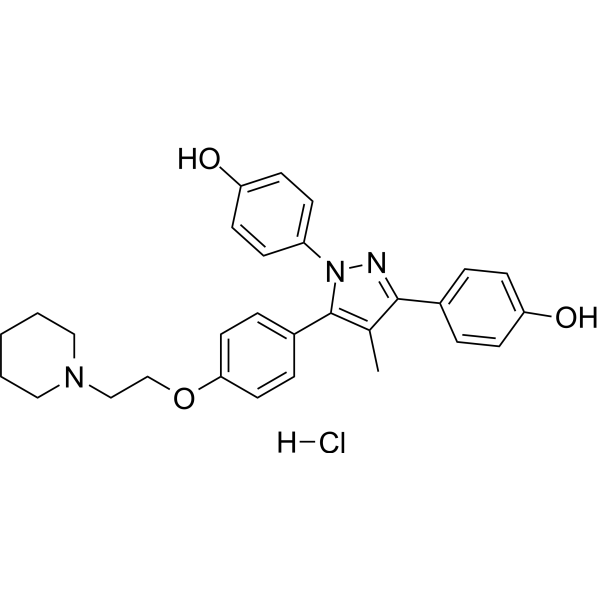Physicochemical Properties
| Molecular Formula | C29H32CLN3O3 |
| Molecular Weight | 506.03568649292 |
| Exact Mass | 505.213 |
| CAS # | 2863676-89-3 |
| Related CAS # | MPP dihydrochloride;911295-24-4 |
| PubChem CID | 163408961 |
| Appearance | White to off-white solid powder |
| Hydrogen Bond Donor Count | 3 |
| Hydrogen Bond Acceptor Count | 5 |
| Rotatable Bond Count | 7 |
| Heavy Atom Count | 36 |
| Complexity | 621 |
| Defined Atom Stereocenter Count | 0 |
| InChi Key | NUFZYMONJXOTFN-UHFFFAOYSA-N |
| InChi Code | InChI=1S/C29H31N3O3.ClH/c1-21-28(22-5-11-25(33)12-6-22)30-32(24-9-13-26(34)14-10-24)29(21)23-7-15-27(16-8-23)35-20-19-31-17-3-2-4-18-31;/h5-16,33-34H,2-4,17-20H2,1H3;1H |
| Chemical Name | 4-[1-(4-hydroxyphenyl)-4-methyl-5-[4-(2-piperidin-1-ylethoxy)phenyl]pyrazol-3-yl]phenol;hydrochloride |
| HS Tariff Code | 2934.99.9001 |
| Storage |
Powder-20°C 3 years 4°C 2 years In solvent -80°C 6 months -20°C 1 month Note: Please store this product in a sealed and protected environment, avoid exposure to moisture. |
| Shipping Condition | Room temperature (This product is stable at ambient temperature for a few days during ordinary shipping and time spent in Customs) |
Biological Activity
| Targets | ERα ERβ |
| ln Vitro | In RL95-2 cells, MPP (1, 5, 10, 25, 50, and 100 µM; 24 h) reduces cell viability with an IC50 value of 20.01 µM[1]. At a dose of 10 μM, MPP dihydrochloride has antiproliferative action in RL95-2 cells[1]. MPP dihydrochloride (20 µM; 24 h) decreases ERα phosphorylation but does not change Akt phosphorylation. MPP dihydrochloride lowers the p-ERα/ERα ratio [1]. |
| ln Vivo | Percent prepulse inhibition (PPI) is dose-dependently attenuated by MPP (low dose: 20 μg/kg body weight; high dose: 200 μg/kg body weight)[2]. |
| Cell Assay |
Cell Viability Assay[1] Cell Types: RL95-2 endometrial cancer cells Tested Concentrations: 1, 5, 10, 25, 50 and 100 µM Incubation Duration: 24 hrs (hours) Experimental Results: The treatment with 25 µM, 50 µM and 100 µM for 24 h diminished cell viability Dramatically. However, cell viability was not Dramatically changed by MPP dihydrochloride at concentration below 25 µM. Cell Proliferation Assay[1] Cell Types: RL95-2 endometrium cancer cells Tested Concentrations: 10, 15, 20 and 25 µM Incubation Duration: 72 hrs (hours) Experimental Results: demonstrated antiproliferative activity at a concentration of 10 μM. Western Blot Analysis[1] Cell Types: RL95-2 endometrium cancer cells Tested Concentrations: 20 µM Incubation Duration: 24 hrs (hours) Experimental Results: decreased the phosphorylation of ERα, while it did not alter the phosphorylation of Akt. decreased the ratio of p-ERα/ERα compared to the control group. |
| Animal Protocol |
Animal/Disease Models: Male C57BL/6N mice at the age of 9-10 weeks[2] Doses: Low dose (20 μg/kg body weight) or high dose (200 μg/kg body weight) Route of Administration: Administered subcutaneously (sc) (sc) injected; injection volume of 5 mL/kg; 60 min before PPI testing Experimental Results: Led to a dose-dependent attenuation of percent PPI. Pretreatment with 200 μg/kg diminished the mean percent PPI scores by ~30%. |
| References |
[1]. α-Chaconine and α-Solanine Inhibit RL95-2 Endometrium Cancer Cell Proliferation by Reducing Expression of Akt (Ser473) and ERα (Ser167). Nutrients. 2018 May 25;10(6). pii: E672. [2]. Effects of selective estrogen receptor alpha and beta modulators on prepulse inhibition in male mice. Psychopharmacology (Berl). 2015 Aug;232(16):2981-94. [3]. The effects of the selective estrogen receptor modulators, methyl-piperidino-pyrazole (MPP), and raloxifene in normal and cancerous endometrial cell lines and in the murine uterus. Mol Reprod Dev. 2006 Aug;73(8):1034-44. |
Solubility Data
| Solubility (In Vitro) | DMSO : 250 mg/mL (494.03 mM) |
| Solubility (In Vivo) |
Solubility in Formulation 1: ≥ 2.08 mg/mL (4.11 mM) (saturation unknown) in 10% DMSO + 40% PEG300 + 5% Tween80 + 45% Saline (add these co-solvents sequentially from left to right, and one by one), clear solution. For example, if 1 mL of working solution is to be prepared, you can add 100 μL of 20.8 mg/mL clear DMSO stock solution to 400 μL PEG300 and mix evenly; then add 50 μL Tween-80 to the above solution and mix evenly; then add 450 μL normal saline to adjust the volume to 1 mL. Preparation of saline: Dissolve 0.9 g of sodium chloride in 100 mL ddH₂ O to obtain a clear solution. Solubility in Formulation 2: ≥ 2.08 mg/mL (4.11 mM) (saturation unknown) in 10% DMSO + 90% (20% SBE-β-CD in Saline) (add these co-solvents sequentially from left to right, and one by one), clear solution. For example, if 1 mL of working solution is to be prepared, you can add 100 μL of 20.8 mg/mL clear DMSO stock solution to 900 μL of 20% SBE-β-CD physiological saline solution and mix evenly. Preparation of 20% SBE-β-CD in Saline (4°C,1 week): Dissolve 2 g SBE-β-CD in 10 mL saline to obtain a clear solution. Solubility in Formulation 3: ≥ 2.08 mg/mL (4.11 mM) (saturation unknown) in 10% DMSO + 90% Corn Oil (add these co-solvents sequentially from left to right, and one by one), clear solution. For example, if 1 mL of working solution is to be prepared, you can add 100 μL of 20.8 mg/mL clear DMSO stock solution to 900 μL of corn oil and mix evenly. (Please use freshly prepared in vivo formulations for optimal results.) |
| Preparing Stock Solutions | 1 mg | 5 mg | 10 mg | |
| 1 mM | 1.9761 mL | 9.8806 mL | 19.7613 mL | |
| 5 mM | 0.3952 mL | 1.9761 mL | 3.9523 mL | |
| 10 mM | 0.1976 mL | 0.9881 mL | 1.9761 mL |
